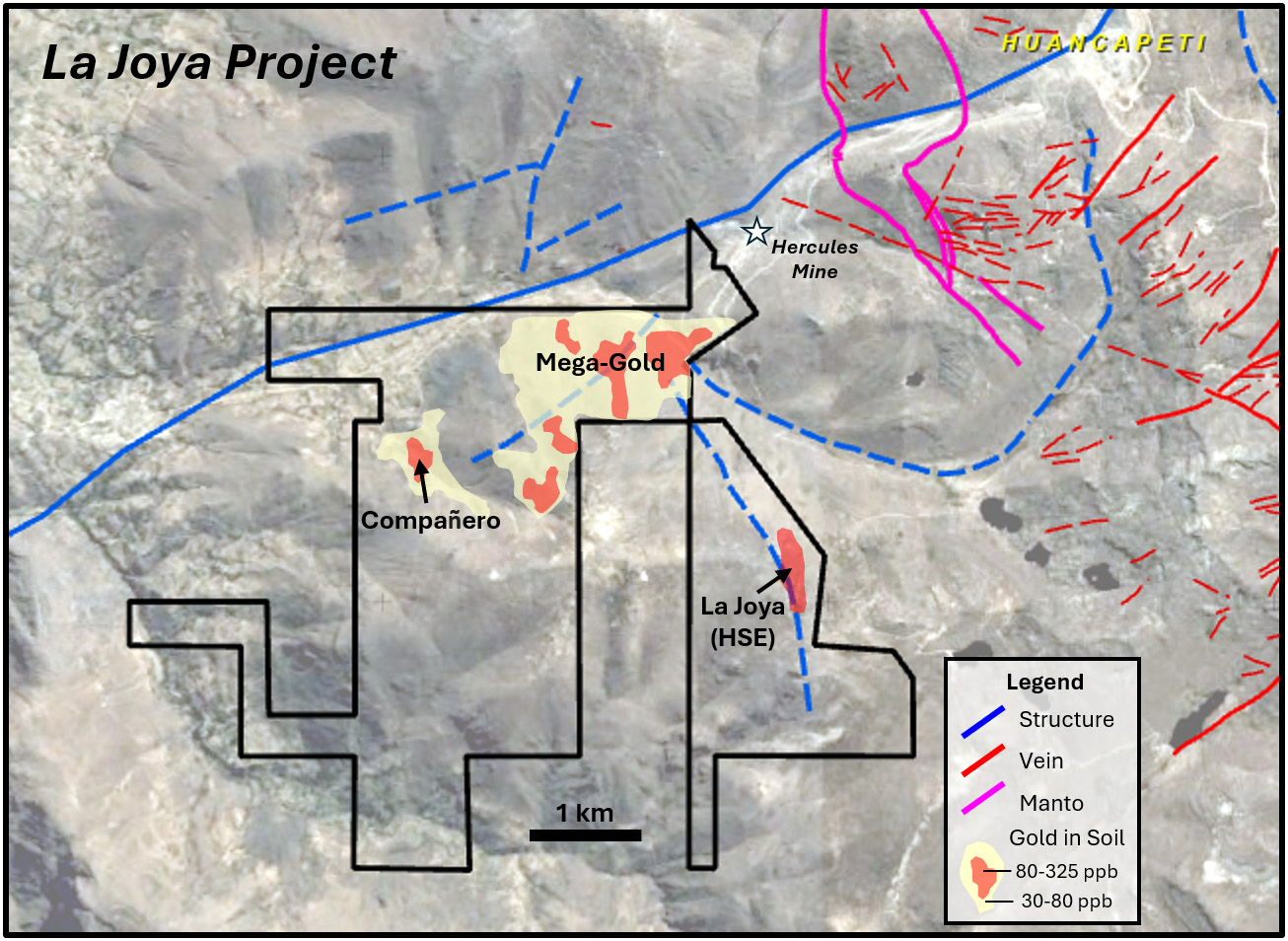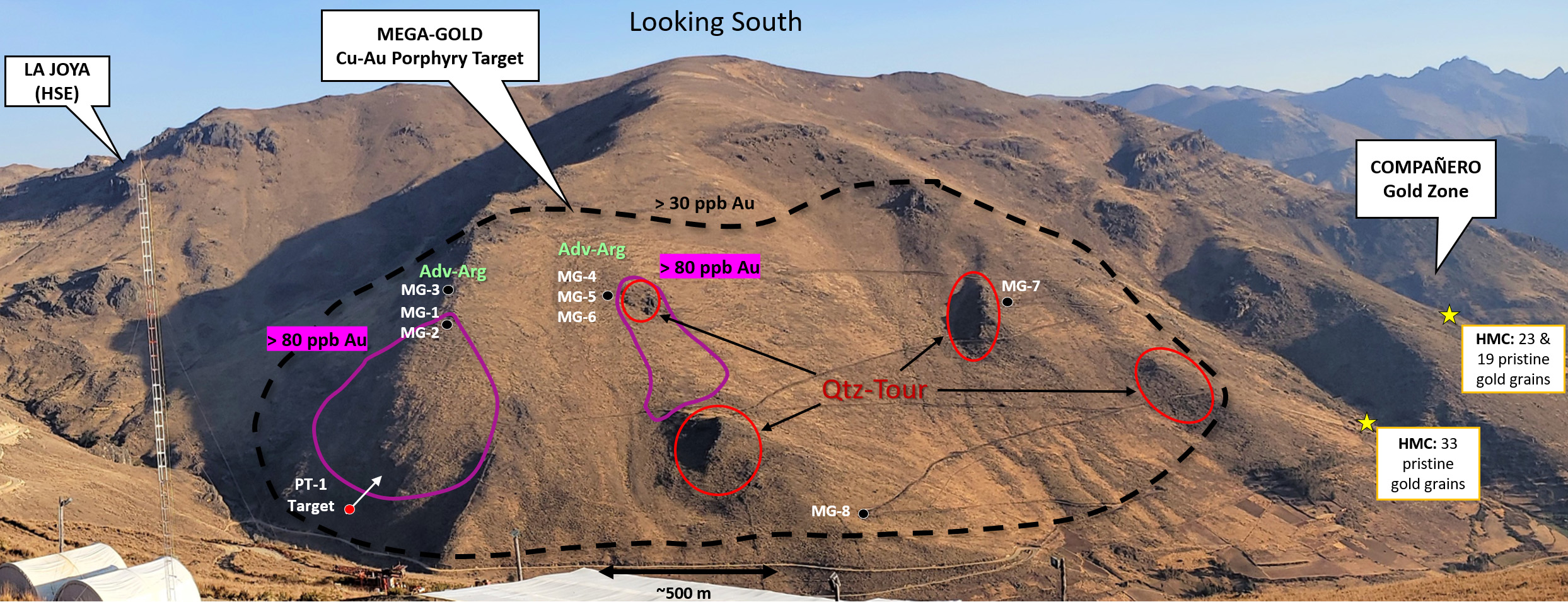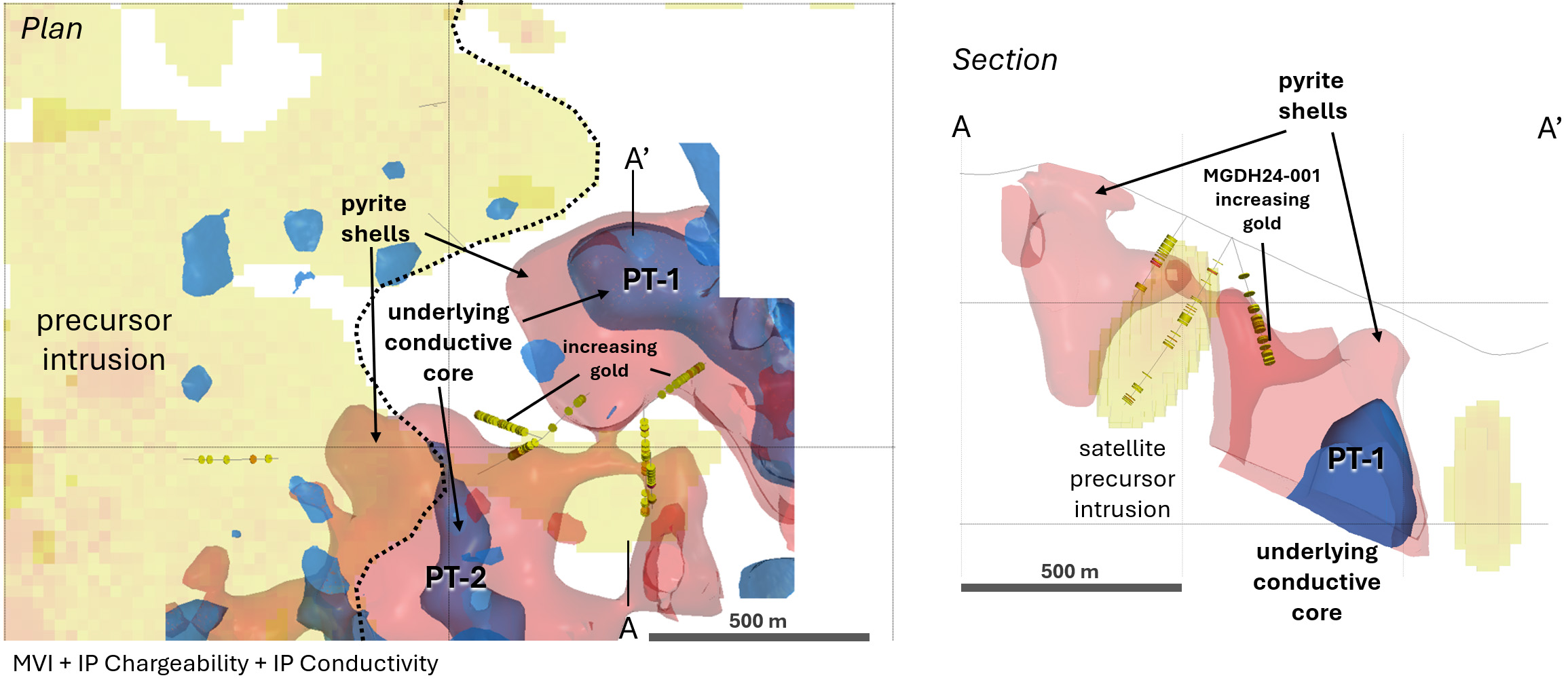La Joya Project, Peru
The La Joya project is located in the Ancash Province of Peru within the Cordillera Negra, 35 km south of the world-class Pierina gold mine. The project is part of the Aija-Ticapampa district with several active mines and processing plants. The project is accessed by paved roads driving north from Lima (~7 hours) to the town of Recuay, then a 30-minute drive west on an improved gravel road to the project. Alternatively, commercial flights operate between Lima and Huaraz, followed by a 1-hour drive to the property.
Chakana began exploring the western side of the Aija-Ticapampa district in Ancash in 2017, initially focusing on outcropping mineralized tourmaline breccia pipes on the Soledad property, optioned from Condor Resources. Additional mineralized breccia pipes were discovered south of the Soledad property, leading to two additional options (Aija and Barrick options), forming a contiguous land position covering over 4,000 hectares. Conceptually, the Company believes that the tourmaline breccia pipes are related to an underlying mineralized porphyry copper-gold system. Extensive exploration and drilling were completed between 2017-2022, leading to an initial inferred resource on seven breccia pipes on the Condor and Aija options (see the technical report titled “Independent Technical Report for the Soledad Copper Project, Ancash Department, Peru” dated February 23, 2022, available under the Chakana’s issuer profile at www.sedarplus.ca). As exploration proceeded to the south, an intrusive center was recognized that management believes is the source of the mineralized breccia pipes. Referred to as the Mega-Gold target, this 2.5 km2 area is characterized by anomalous gold in soils, pervasive hydrothermal alteration, and geophysical responses typical of mineralized porphyry systems. In addition, 2 km further south, evidence of a preserved lithocap environment with advanced argillic alteration was identified (La Joya target) that is believed to be related to the Mega-Gold intrusive center. In the southwest part of the Barrick option, a zone of strongly mineralized copper-gold breccia (Compañero target) exists beyond the limits of the Mega-Gold intrusive center.
Both the Condor and Aija options were subject to steep property payments that were deemed by management to exceed the value of the properties, leading to a decision to relinquish the Condor and Aija properties to focus on the highly prospective Barrick option, referred to as the La Joya Project (Figure 1). The Barrick option has no cash payments and is based on expenditures in the ground (see news releases dated July 16, 2018, and October 12, 2021). The Company believes that this is both fiscally responsible and offers the greatest potential for a major discovery. As a result of terminating the Condor and Aija agreements, the Company has no resource estimate on the Soledad project.
Figure 1 - Map showing the 1,600 hectare La Joya Project located in Ancash, Peru, incorporating the Barrick option and Chakana-owned concessions. The currently known prospective areas are highlighted associated with anomalous gold in soil - La Joya, Mega-Gold, and Compañero. Principal structures, veins, and mantos in the western part of the Aija-Ticapampa mining district are also shown.
The La Joya project includes three principal target areas (Figures 1 and 2):
- the Mega-Gold intrusive center, where 2024 scout drilling confirmed a high-level porphyry environment with two yet to be tested discrete porphyry targets; and
- the La Joya high-sulfidation epithermal (HSE) system, where minimal 2024 drilling confirmed high-grade silver mineralization including 1,005.0 gpt silver and 0.45 gpt gold over 0.75m within an alteration zone with 700 meters of strike length; and
- the Compañero gold zone, where hydrothermal breccia is exposed at surface in several outcrops over an area of 250 metres diameter with channel sample assays up to 14.4 gpt gold.
Figure 2 – Photo looking south showing the three principal target areas that make up the La Joya Project – 1) La Joya (HSE), 2) Mega-Gold intrusive center, and 3) Compañero gold zone. Black dots show location of initial scout holes drilled at Mega-Gold in 2024.
2025 Exploration Plan
The La Joya (HSE) and Mega-Gold prospects are fully permitted for additional drilling. At La Joya (HSE), detailed mapping and a detail ground geophysical survey will be completed prior to drilling. The target is a stratigraphically hosted bulk tonnage precious metals deposit. Approximately 1,900m of drilling is anticipated. At Mega-Gold, a definitive drill test of the PT-1 porphyry target is planned with an anticipated depth of 400m. The final stage of permitting allowing drilling at the Compañero gold zone will be completed. The environmental permit has been awarded with the initiation of activities remaining to be completed.
La Joya High-Sulfidation Epithermal Prospect
The La Joya (HSE) target area is associated with high-sulfidation advanced argillic alteration consisting of vuggy silica, alunite, dickite, zunyite, diaspore, and pyrophyllite. The zone of alteration extends 700 metres in a north-south direction at an elevation of approximately 4,500 metres (Figures 1 and 2). Surface rock samples collected from the alteration zone have silver and gold values up to 1,300 gpt and 0.36 gpt, respectively.
Three shallow holes were completed at La Joya in 2024 for a total of 465.5 m. The holes were planned to drill beneath strongly silicified volcanic rocks where zones of vuggy silica alteration returned strongly anomalous values in silver and gold. The strongest mineralization was observed in hole LJDH24-002 with 323.6 gpt silver and 0.25 gpt gold over 4.5 m from 58.0 m depth. Within this interval residual vuggy silica is present over a 0.75m interval with 1,005.0 gpt silver and 0.45 gpt gold (see news release dated August 29, 2024). The mineralized interval is hosted within andesite tuff that shows evidence of advanced argillic alteration. Shallow drilling confirmed high-grade precious metal mineralization hosted in prospective volcanic stratigraphy and warrants additional drilling.
Mega-Gold Intrusive Center
The Mega-Gold intrusive center is a very large area occupying 2.5 km2 with anomalous gold in soil overlying pervasive tourmaline-quartz-white mica alteration, overprinted by localized advanced argillic alteration zones and tourmaline breccias. The target area is underlain by older andesitic tuff (Calipuy Formation) and a pre-mineral granodiorite, thought to be the first pulse of intrusive activity in the Aija-Ticapampa district. Within the gold anomaly is a distinct Offset (3D) induced polarization chargeability feature coincident with the soil anomaly. Beneath the strong chargeability zones are discrete zones of conductivity, believed to reflect mineralizing intrusions.
An initial “proof-of-concept” drilling program was completed in 2024 to test the idea that the Mega-Gold intrusive center is part of a mineralized porphyry system. A total of eight scout drill holes were completed across a broad area totaling 2,425 m. These holes display a variety of vein types (principally B and D veins); elevated gold, copper and molybdenum; and hydrothermal alteration zoning consistent with a high-level porphyry environment (see news release dated August 29, 2024). All holes encountered pyrite-chalcopyrite-molybdenite mineralization hosted in veins. Higher temperature alteration minerals suggesting proximity to a porphyry are most strongly developed in the three eastern-most holes drilled in the Mega-Gold target area (see news release dated July 2, 2024). These holes also exhibit narrow zones of strong mineralization in MGDH24-002 with 2.0 m of 1.8 gpt gold and 0.35% copper from 89.0 m depth, and 1.5 m of 11.05 gpt gold from 127.5 m depth in MGDH24-003, confirming a mineralized fluid source at depth. The strong IP chargeability zones are interpreted to be two separate pyrite shells related to underlying porphyry intrusions. Strongly conductive rock beneath the pyrite shells are potential zones of porphyry mineralization (PT-1, Figure 3) and warrant additional drilling.
Figure 3 – Map showing high-priority discrete porphyry targets PT-1 and PT-2 with drill holes from 2024 drilling. Disc shapes on drill holes are >80 ppb gold. Section on right shows relation between induced polarization chargeability outlining pyrite shells (red) and underlying conductive features from the induced polarization resistivity model (blue).
Compañero Gold Prospect
The Compañero gold zone is located in the southwest part of the La Joya project adjacent to a pre-mineral intrusion. Mineralized hydrothermal breccias are exposed at surface in several outcrops within an area of approximately 250m in diameter. The breccias are strongly anomalous in gold with up to 14.4 gpt in channel samples and secondary copper minerals are noted in several localities. Three heavy mineral concentrate samples collected downstream and adjacent to the Compañero zone contain 19, 23, and 33 pristine gold grains. There has been no drilling in the Compañero area. The initiation of activities should be competed to allow drill testing the high-grade breccia exposed at surface.



